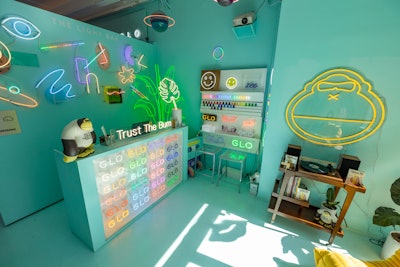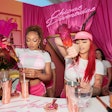
Not all events are created equal. Sure, planners are always looking to create memorable, out-of-the-box experiences for their attendees, but how does that differ from a business-facing B2B event (where you want to facilitate guest interaction) and a consumer-facing B2C event (where you want to pull out all the experiential stops for potential consumers)?
BizBash sat down with Jamie D’Attoma, the executive vice president and partner at SHADOW, which celebrated its 15th anniversary earlier this year. The New York-based creative marketing and communications agency specializes in media relations, influencer marketing, experiential and event production, and content development, among other disciplines.
How do you define the difference between B2B and B2C events? For D’Attoma, “both events require experiential elements that are unique and engaging.” He noted that variations are apparent when it comes to audience and programming. “B2B-focused events—which we produce primarily for media and influencers—need educational components that highlight a key brand or product points to help encourage key messaging through brand storytelling,” he explained, citing an event with Sun Bum and Name Glo SHADOW executed on May 5.
The agency took over neon sign shop Name Glo on Manhattan’s Lower East Side for a B2B, private event “hosted for media to get them excited about Sun Bum’s new Original Glow SPF 30 Sunscreen Face Lotion.” In order to achieve that, “one of the most significant factors is the number of attendees,” D’Attoma said, noting that only 20 “of New York City’s top journalists and influencers within the beauty sector” were invited. Twenty “of New York City’s top journalists and influencers within the beauty sector” were invited, and the intimacy allowed for an educational opportunity surrounding the importance of SPF. Guests were also gifted Sun Bum products and were able to create a custom neon sign, courtesy of Name Glo.Photo: Mark Claudio for Sun Bum
Twenty “of New York City’s top journalists and influencers within the beauty sector” were invited, and the intimacy allowed for an educational opportunity surrounding the importance of SPF. Guests were also gifted Sun Bum products and were able to create a custom neon sign, courtesy of Name Glo.Photo: Mark Claudio for Sun Bum
The intimacy allowed for an educational opportunity surrounding the importance of SPF when it comes to protecting skin from the sun—fitting for an event that took place during Skin Cancer Awareness Month. And with an invite list that prioritized quality over quantity (representatives from Allure, Cosmopolitan, and Glamour were in attendance), Sun Bum was able to gift the face lotion it was promoting, and each attendee was able to create a custom neon sign, courtesy of Name Glo.
When it comes to B2B experiences of this kind, D’Attoma said the greatest challenge is “guaranteeing attendance,” especially when it comes to hosting “editors and influencers who have jam-packed schedules.” To combat that challenge, the executive vice president encouraged planners to “always try to offer a unique experience to pique interest,” and remember “the importance of offering something unique and custom.”
He also noted that thoughtful touches “create genuinely custom experiences that are fueled by creativity,” thus avoiding burnout across influencers and providing “multiple touch points for them to be able to capture content.”
A tip? Utilize time slots or appointment bookings. They’re “essential when you want to ensure each attendee receives the same amount of focus and attention during their guest experience,” D’Attoma suggested. “It’s also important from a run-of-show perspective when offering things like styling touch-ups, product demonstrations, or guided experiences,” he added.
Following the Sun Bum event, “attendees raved about their neon signs,” D’Attoma recalled. He also considered the gift—which allowed guests “to bring Sun Bum’s glow into their home” and made it “clear we gave something of real value to people”—the greatest success of the event. The favor was also attributed to the reason why so many of the influencers “not only shared the event experience day of, but also used the product in their getting ready routine and shared their new love of SPF.”
These videos helped contribute to ROI, which D’Attoma pointed out isn’t necessarily about immediate sales when hosting a B2B event that focuses so heavily on creating a personalized experience for select individuals on an invite-only list. For this event, for example, D’Attoma and his team were looking at “organic social content captured from an influencer in attendance [and] a write-up of the experience in a media outlet.” At the Star Wars Celebration, SHADOW put on a B2C event to celebrate the launch of Casetify's Star Wars collection that catered to more than 60,000 fans across the country. Cue “a wow-worthy, stop-and-stare custom booth” complete with a “Star Wars cockpit photo op installation” that D’Attoma said “helped us stand out among the many sponsorship activations at the convention center and encouraged social sharing.”Photo: August Reinhardt for Casetify
At the Star Wars Celebration, SHADOW put on a B2C event to celebrate the launch of Casetify's Star Wars collection that catered to more than 60,000 fans across the country. Cue “a wow-worthy, stop-and-stare custom booth” complete with a “Star Wars cockpit photo op installation” that D’Attoma said “helped us stand out among the many sponsorship activations at the convention center and encouraged social sharing.”Photo: August Reinhardt for Casetify
However, no matter business- or consumer-facing, “ROIs and KPIs change with each event depending on the goals set forth by the client,” D’Attoma said, emphasizing the importance of “client relationships with clear communication and transparency.”
These points were especially important when SHADOW executed the launch of Casetify’s Star Wars collection at the Star Wars Celebration at the Anaheim Convention Center—a B2C extravaganza that took place May 26-29 and welcomed more than 60,000 guests.
The goal? “To ensure Casetify’s new collection was top-of-mind for the franchise loyalists in attendance,” D’Attoma recalled, pointing out that “the Star Wars Celebration had been on hiatus for two years due to COVID,” so a lot of anticipation from fans accompanied the event’s return. He said this contributed to the challenge of activating at the event, but explained that the answer was “keeping up with demand, adding additional sales staff, and remaining calm while accommodating guests’ needs throughout the day.”
D'Attoma also noted that when it comes to producing a B2C event, “it’s less about type and more about whether the concept and production can be scaled up or down.”
He took his own advice to accommodate the tens of thousands of attendees with high expectations—as well as drive sales and brand awareness—at the Star Wars celebration. Cue “a wow-worthy, stop-and-stare custom booth” complete with a “Star Wars cockpit photo op installation.” D’Attoma said that the branded, memorable moment “helped us stand out among the many sponsorship activations at the convention center and encouraged social sharing.” SHADOW created an activation for e.l.f Cosmetics and Dunkin’ in New York City’s Meatpacking District, which D'Attoma described as a "hybrid in the sense that it catered to both editors/influencers as well as consumers."Photo: Mark Claudio
SHADOW created an activation for e.l.f Cosmetics and Dunkin’ in New York City’s Meatpacking District, which D'Attoma described as a "hybrid in the sense that it catered to both editors/influencers as well as consumers."Photo: Mark Claudio More than 50 editors and influencers attended the pop-up, plus 500 consumers. The customers were gifted to-go-style bags of branded products, and 15 editors and influencers could book makeup appointments in the “sweet suite” space.Photo: Mark Claudio
More than 50 editors and influencers attended the pop-up, plus 500 consumers. The customers were gifted to-go-style bags of branded products, and 15 editors and influencers could book makeup appointments in the “sweet suite” space.Photo: Mark Claudio
However, he suggested planners still consider hosting influencers because of their, well, influence. “The power of influencers is that they can spread brand awareness and share content authentically with their community of followers,” D’Attoma said, adding that this unique method of promotion “has proven very successful for both business- and consumer-facing events.”
The key to hosting consumers and influencers or media? “Customize certain elements to ensure that media receives product demos or 1-to-1 education, or consumers receive takeaway products that are exclusive to the experience.”
SHADOW modeled this at an activation for e.l.f Cosmetics and Dunkin’ in New York City’s Meatpacking District, which was “selected in part for its strong foot traffic and accessibility.” More than 50 editors and influencers attended, plus 500 consumers, and while hundreds of customers were gifted to-go-style bags of branded products, 15 editors and influencers could book makeup appointments in the “sweet suite” space.
At the end of the day, D’Attoma says understanding the difference between B2B and B2C “helps you produce the best experiential results for your clients and allows them to see the benefit of each type of event.”
Looking to create a successful business- or consumer-facing event of your own? Here are D’Attoma’s key takeaways:
- “Ensure you’re always on the same page with your clients about the event’s goals and objectives so they feel assured that all of the hard work and time is worth the monetary investment to pull it off!”
- Consider influencers, no matter the event. “The power of influencers is that they can spread brand awareness and share content authentically with their community of followers.”
When planning a B2B event:
- “Understand the importance of offering something unique and custom.”
- Utilize “educational components to highlight a key brand or product point.” This will “help encourage key messaging through brand storytelling.”
- “You must offer multiple touch points for influencers to be able to capture content.”
- Consider time slots or appointment bookings “to ensure each attendee can receive the same amount of focus and attention.”
When planning a B2C event:
- Think about “whether the concept and production can be scaled up or down.”
- Consider hiring additional sales staff, “which is what we call a champagne problem.”
- Offer “takeaway products that are exclusive to the experience” to further foster a brand’s relationship with its consumers.
- Always keep visibility and traffic flow in mind.



















